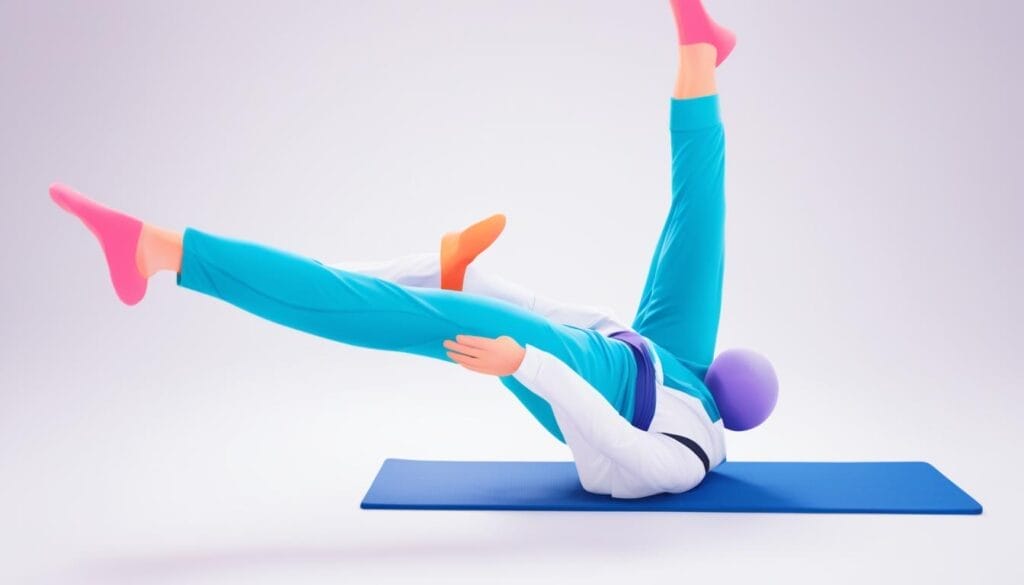Flexibility training is more than just stretching. It’s about leading a freer and livelier life. Because I’ve always felt trapped by my stiffness, I started a mission to enhance my body’s movements and health. To my surprise, sticking to stretching not only improved my movements but also sparked a journey of self-discovery and growth.
My path was filled with lots of stretching and a strict routine. I faced hardships, at times feeling unsure if I could reach my flexibility goals. Yet, every little step forward boosted my confidence and kept me going.
This journey changed both my body and mind. I learned to be consistent, strong, and listen to my body. It reinforced the idea that flexibility is about more than the body. It’s a deep connection with myself and finding harmony in the chaos of life.
I’m thrilled to pass on what I’ve learned from my flexibility journey. This article is for anyone, whether just starting or wanting to go further. You’ll get tips, guidance, and the spark you need for a life with bigger moves ahead.
Key Takeaways
- Consistency and dedication are crucial in improving flexibility through stretching exercises.
- Listening to your body’s feedback and adapting your training based on your individual limits is essential.
- Flexibility training should be personalized and enjoyable to maintain long-term commitment.
- Flexibility results vary for each individual, and there is no set time frame for achieving maximum flexibility.
- Flexibility training encompasses not just physical benefits but also mental and emotional growth.
The Importance of Consistency and Listening to Your Body
Starting my flexibility journey, I thought doing the same stretches daily would work wonders. I quickly learned it wasn’t that simple. Flexibility in adults needs you to be consistent and in tune with your body. Understanding its limits and what it needs is a must.
Doing stretches daily is key to becoming more flexible. It helps by making your movements smoother and wider over time. Immediate results aren’t the goal; it’s about making stretching a regular part of your day. This process is about pushing yourself while enjoying it.
“Consistency is key. It’s the indispensable ingredient that brings forth progress and transformation.” – Simon Gomm
But, listening to your body is as important as the stretches themselves. Everyone is different, with unique abilities and limits. Pushing too hard without heeding your body’s warnings can result in harm. It’s important to know when to stop, giving your body the break it needs.
As you get more flexible, your training must evolve too. By staying flexible in how you train, you ensure progress continues. Adapting your methods as needed keeps the challenge alive. There’s no universal way to become more flexible, so being adaptable is vital.
Don’t forget about rest and recovery. This time is when your muscles heal and grow. Neglecting rest can lead to overtraining, which slows you down. Ensuring your body gets the rest it needs is as important as the training itself.
Flexibility training is personal, needing constant effort and understanding of your own limits. By staying focused, listening to what your body tells you, and being open to change, you’ll see real flexibility gains.
Flexibility Training Tips for Consistency and Effective Listening:
- Establish a regular stretching routine and stick to it.
- Pay attention to any discomfort or strain during stretches.
- Modify exercises or seek professional guidance if you experience pain.
- Take regular breaks and incorporate rest days into your training schedule.
- Learn to differentiate between discomfort from stretching and actual pain.
- Be patient and allow your body to progress at its own pace.
Remember, flexibility is a lifelong journey, and enjoying it is vital. Listen to your body, respect its needs, and stay adaptable in your approach. These are the keys to improving your flexibility, gaining more movement, and building a strong body.
Finding the Right Approach: Individualisation and Enjoyment
Finding the best way to get flexible has been important for me. I tried different programs and learned a lot from them. But, I truly started making progress when I made it personal and fun. I mix different ways to stretch to fit my needs and enjoy it more.
I don’t just follow a fixed plan. I make my flexibility training personal. This means choosing exercises that suit my body. Remember, what’s good for someone else might not be good for you. By knowing my body’s needs, I’ve made a training plan that’s just right for me.
Setting my own flexibility goals has been a big win. Knowing what I wanted from my training made a real difference. I’m working on my splits and how far I can move my body. It keeps me going and shows me I’m getting better.
Enjoyable Stretching for Optimal Flexibility Improvements
Making stretching fun was a game changer for me. At first, stretching seemed like a boring must-do. But, when I added things I like, my mindset changed. Now, I enjoy and look forward to it.
I’ve tried all kinds of stretching to find what I love. From yoga to dance stretches, even aerial exercises. So not only do they push my flexibility, but they’re also fun. This mix keeps me excited about each session.
Remember, what’s fun for me might not be fun for you. The real trick is to find what you love doing. This keeps you on track and enjoying the journey.
Finding the right way to train has led to great progress for me. By making it my own and enjoyable, my flexibility is better. So, mix things up, set clear goals, and enjoy getting flexible.

| Flexibility Programs | Flexibility Training Methods | Individualised Approach | Flexibility Goals | Enjoyable Stretching | Flexibility Improvements |
|---|---|---|---|---|---|
| Explore different flexibility programs to find what works best for you | Experiment with various flexibility training methods like yoga, Pilates, and dance-inspired stretches | Personalise your flexibility training to suit your body’s unique needs and limitations | Set specific flexibility goals to stay motivated and track your progress | Incorporate enjoyable stretching activities to make your training sessions more engaging | Achieve significant improvements in flexibility through the right approach |
The Journey of Flexibility: Long-Term Commitment and Patience
Gaining flexibility isn’t quick. It’s a journey needing a flexible life, commitment over time, and lots of patience. While some see quick changes, most people take time. Improvement comes with regular practice that continues for a long time.
Different folks see different results in their flexibility. Factors like genes, age, and past physical activities play a role. Knowing that every body reacts differently to flexibility work is crucial. Progress is unique to each person and depends on things like how flexible you are naturally, your muscle strength, and overall fitness.
Patience is key in becoming more flexible over time. Instead of only looking for quick wins, setting a flexible mindset is important. Real gains happen when you practice regularly over the long term. This approach values ongoing efforts.
Keeping flexible means stretching regularly. Include flexibility exercises in your week to stop losing ground and enjoy your efforts. This way, you keep or even boost your mobility and how far you can move.
I’ve seen big changes in my flexibility by working hard and staying patient. Committing to ongoing exercise has made a real difference. This journey taught me that it’s worth the effort and time to grow.
Flexibility work is more than just the body – it’s also about mental toughness and staying emotionally strong. It’s helped me learn how to face tough times and break my own limits. I’ve learnt that change is good, and strong willpower can do wonders.
Starting your flexibility journey is rewarding. It’s a chance for self-improvement, growth, and good health. Stick with it for the long haul, with patience and an open mind. You’ll be amazed at the lively and flexible life you can lead.
Flexibility Training Tips for Long-Term Success
- Consistency is key: Incorporate regular stretching sessions into your weekly routine.
- Listen to your body: Take note of any discomfort or pain and adjust your training accordingly.
- Track your progress: Keep a record of your flexibility achievements to motivate yourself and celebrate milestones.
- Vary your exercises: Mix up different stretching techniques and flexibility drills to keep your training engaging and effective.
- Seek professional guidance: Consider working with a certified flexibility coach or trainer to customize your training program for optimal results.
Long-Term Flexibility Commitment: My Personal Journey
| Date | Flexibility Results | Training Techniques |
|---|---|---|
| January 2020 | Minimal flexibility | Basic static stretches, yoga classes |
| June 2020 | Noticeable improvement in range of motion | Dynamic stretches, foam rolling, Pilates |
| January 2021 | Significant increase in flexibility and mobility | Active isolated stretching, resistance band exercises |
| July 2021 | Advanced level of flexibility attained | Partner-assisted stretching |
The table above shows my long flexibility journey’s outcomes. By mixing up my training, tackling new challenges, and staying committed, I improved from very little flexibility to an advanced level.
Summing It Up
Flexibility training changed my life, making it more flexible and active. Thanks to flexibility training, my health and thinking have gotten a lot better.
Working on my flexibility didn’t just help my body. It also made my mind stronger and helped me deal with things better. Now, I’m more open-minded and calm in any situation.
For me, flexibility is more than just exercises. It’s part of how I live. I listen to what my body tells me, adjust my training, and love stretching. Doing it my way has been fun and rewarding.
I think everyone should try flexibility training. Its positive effects reach far and wide. So, open yourself up to flexibility and see a whole new level of well-being and happiness.
FAQ
What is flexibility training?
Flexibility training means doing exercises to stretch your body. This makes your muscles and joints more flexible and increases your movement.
What are the benefits of flexibility training?
It helps you move better and stand straighter. It’s good for sports, lowers your injury risk, and makes you feel healthy. So, it’s useful in many ways.
What are some examples of flexibility exercises?
Some exercises include sitting and reaching your toes, moving your arms in big circles, and trying different yoga poses. Pilates and drills that help you move easier are good too.
How can I improve flexibility?
Stretch often and in different ways. Listen to what your body tells you. Don’t forget to rest. Adjust your training to what you can do. This will make you more flexible.
Is it important to personalize my flexibility training?
Yes, making your flexibility training fit your life and goals matters a lot. It helps you keep at it and succeed in the long run.
How long does it take to achieve maximum flexibility?
Everyone is different. So, how fast you get more flexible varies. It usually takes lots of regular exercise over time to see big changes.
Do I need to maintain flexibility training to keep the benefits?
Yes, being flexible needs regular work. Keep doing your exercises. This way, you keep your body working well and avoid losing flexibility as you get older.
What other benefits can flexibility training bring?
Being flexible doesn’t just help your body. It can make you feel happier and less stressed. You become more aware of your body too. So, it’s good for your mind and soul.
Source Links
Share Me:
READY TO UNLEASH
YOUR BEST SELF?
Click “Sign Me Up!” And Start Your Fitness Transformation!





